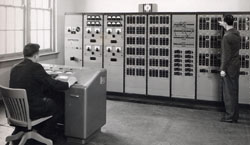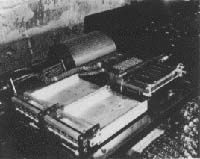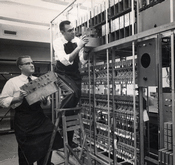Innovative research also has been a top priority for the Department of Electrical and Computer Engineering at Iowa State University. Our faculty, graduate students, and alumni have developed or played a role in creating many important technologies such as GPS devices, cell phones, computers, and more.
- Early Electrical Engineering Research
- Electronics and Power Transmission Research
- Computer Technology Research
- Early GPS Research
- New Research Areas
- Industry Funding of Research and Laboratories
Early Electrical Engineering Research
The department began improving its equipment and facilities just before the United States entered World War I. College of Engineering Dean Anson Marston explained that the increasing number of telephones across Iowa necessitated the department teach telephone engineering courses and conduct research in this area. In 1915, the department purchased new telephone equipment to augment its instruction in telephony, which became a required course for all electrical engineering students until 1924. Radio instruction was discontinued during World War I, but resumed in 1922.
Electronics and Power Transmission Research
In 1940, then-Department Head Mervin S. Coover authorized new labs in electronics and power transmission, including an improved oscillograph lab and expanded facilities for communications research such as new television equipment.

In 1948, Warren B. Boast, John D. “Jack” Ryder, and College of Engineering Dean George R. Town began constructing a network analyzer, a scaled model of an actual electrical generation and distribution system. Instead of using 60 cycles per second (now called Hertz), the AC Network Analyzer used a frequency of 10,000 Hertz. This reduced the size of capacitors and inductors by a factor of approximately 166. After the AC Network Analyzer was completed in 1950, several Iowa and Nebraska power utilities paid Iowa State to use the model until the 1970s. This relationship between the department and industry resulted in Iowa State having more electrical engineering PhDs employed in industry than any other institution during the 1950s. During this time, Coover provided a valuable blueprint to demonstrate that the department and industry could cooperate in a productive way.
In the early 1960s as part of the new biomedical electronics program, David L. Carlson worked with four collaborators to produce an innovative infant respiratory augmentor. The technology was patented in 1967. The patent earned the university nearly $500,000 in revenue.
In 1962, Anson Marston Distinguished Professor Arthur V. Pohm (MS physics ‘53; PhD physics ‘54) developed a program to improve electronics research and education in the department. Pohm’s efforts resulted in the Affiliate Program in Solid-State Electronics. Companies interested in advancing research in electronics joined the group for an annual fee. This program established a graduate education and research program in solid-state electronics. The fees supported graduate students’ research assistantships.
In the late 1950s and early 1960s, students began gravitating towards studying electronics, computers, and semiconductors, rather than electric power, the department’s traditional focus area. Because of this, the power faculty began to revitalize interest in power systems with industry support.
In 1963, Associate Professor Paul M. Anderson (BSEE ’49; MSEE ’58; PhDEE ’61) and Anson Marston Distinguished Professor Abdel-Aziz Fouad (PhDEE ’56) established the Power Affiliate Research Program (which later became the Electric Power Research Center) to further research and graduate education in electric power systems. Regional power companies joined the group for an annual fee that funded graduate research assistantships.
By the mid-1970s, electric power engineering became multidisciplinary, allowing various engineering disciplines to collaborate to solve increasingly complex and varied power problems. As a result of Anderson and Fouad’s work, power engineering remained a hallmark of the department’s graduate education. The department’s cooperation with industry remains today.

Iowa State University has a long tradition of making great innovations in computing. The university is most well known as the birthplace of the electronic digital computer. In 1939, electrical engineering graduate student Clifford Berry helped John Vincent Atanasoff, a physics professor, create the world’s first electronic digital computer.
In 1955, the university’s Working Committee for Improvement of Computational Facilities began discussing the college’s needs for computing technology. The committee addressed this need by renting an IBM 650. Although this machine was deemed “slow,” “with limited memory,” and “adequate only for performing curtailed projects or pilot computations,” it temporarily met some of the university’s demands until a larger, more powerful computer could be acquired.

The department recognized the university’s need for increased computing technology at this time, so in 1956, faculty and students began building the Cyclone Computer to “develop an experienced group in computer engineering and design on campus.” Funding for the computer came from the university’s Alumni Achievement Fund and the National Science Foundation. The computer was completed in 1959 and was used until 1966. The computer stood 10-feet tall, 12-feet long, and 3-feet wide and contained more than 2,700 vacuum tubes with an original memory capacity of 40,960 binary digits (the memory was eventually increased with a random-access magnetic core system). It performed 600,000 mathematical equations a minute and solved 40 equations with 40 unknown numerals in less than four minutes. The Cyclone Computer also required its own internal air conditioning unit to prevent to from over-heating. It provided a powerful tool for the problem-solving and computational needs for all College of Engineering departments, and it inaugurated coursework in computer engineering and computer science.
In the 1960s, the department also acquired a new analog computer. And by the end of the 1960s, the department maintained its status at the forefront of computer research and development. In 1970, the department purchased a large-scale computer system, Symbol IIR, created by Fairchild Camera and Lens. The Symbol IIR eliminated extensive machine instructions with hundreds of commands and replaced it with a simpler set of instructions composed in English. This made programming the Symbol IIR faster, simpler, and more efficient. The Symbol IIR’s design incorporated 20,000 integrated circuits and handled up to 32 terminals and produce compilation rates per terminal of up to 75,000 statements per minute. According to Professor Robert M. Stewart, Jr., the computer was “a collection of hardware processors, each of which is particularized to the function that it is to perform” such as channel control, editing, memory control, memory reclamation, compilation, and job control.
Throughout the years, the department continued to update its computers to stay on the cutting edge. In 2006, the department purchased the IBM Blue Gene/L supercomputer for bioinformatics research. The computer was among the top 100 fastest computers in the country at the time it was acquired. In 2008, the department received a new National Science Foundation grant to purchase an even more powerful computer.
The U.S. Department of Defense in 1967 created Project Themis, an attempt to create “centers of excellence” among academia by distributing funds to research institutions. Anson Marston Distinguished Professor R. Grover Brown (BSEE ’48; MSEE ’51; PhDEE ’56) proposed research in automatic navigation and control. The program was discontinued at Iowa State in 1973, but not without Brown making significant progress on Doppler satellite systems and the computation of conventional position. Using the Doppler data and processing it directly with a Kalman filter, Brown made contributed significantly to the development of global positioning systems.
Throughout Warren B. Boast’s tenure as department head, he sought to expand the department’s expertise in systems, including the areas of computers, control and communication, microwaves (antenna, theory, microwave circuits and devices, and propagation), and the direct conversion of heat to electricity. Boast hoped that by expanding the department’s systems area, it would remain innovative and on the cutting edge of research.
As the department’s chair beginning in 2003, Anson Marston Distinguished Professor Arun K. Somani brought a multidisciplinary focus for research and communication with him. Today, faculty from multiple traditional research areas collaborate to produce top-quality research in the department’s five strategic research areas: bioengineering; cyber infrastructure; distributed sensing and decision making; energy infrastructure; and materials, devices, and circuits.
Industry Funding of Research Laboratories
In 1975, new Department Chair Julius O. “J.O.” Kopplin oversaw the department through a difficult time of federal and state budget cuts. To continue to attract top faculty, perform cutting-edge research on state-of-the-art lab equipment, and maintain the department’s educational and research excellence, the department began searching more aggressively for funding from outside sources. Several companies and donors came to the department’s aid.
In 1976, ALCOA donated computers, floppy disk drives, and other equipment to the department specifically students to use. Rockwell International Corporation also donated equipment for the Power Electronics Laboratory and Hewlett-Packard’s Corporate Grants Program helped the department upgrade its computers, design stations and software in 1987 and again in 1991. In 1992, Takano Co., based in Nagano, Japan, created an endowment for graduate fellowships in nondestructive evaluation.
In 1999, the Roy J. Carver Charitable Trust and industry partners established the Carver Communication Circuits Laboratory. The department hoped this lab would vault it to the forefront of information technology (IT). Texas Instruments and Rocket Chips also supported the department by providing funds to buy equipment for the lab. According to Professor William Black, the research performed at the lab would help ECpE to “serve as a very important resource for large and small Iowa firms.”
By 2002, the department established the Information Infrastructure Institute (iCUBE), an initiative to promote the development of new IT technologies and their applications to solve real-world problems. The university also launched the CyberInnovation Institute in 2007. The CyberInnovation Institute served as an umbrella to unify several smaller IT-related centers on campus, including the ECpE department’s iCUBE and Information Assurance Center, until 2010. This institute brought together interdisciplinary research teams and industrial partners to address real-world IT problems in areas such as biological sciences, agriculture, engineering, and business.
Teradyne and Micron Technologies also have supported the department. In 2003, Teradyne gave the department a semiconductor test system and Micron Technologies Foundation donated $300,000 for research in microelectronics. These donations and grants kept ECpE on the cutting edge of technology and research.
Today, faculty seek and acquire research funding from several sources, including the National Science Foundation, other governmental agencies, and industry partners. Faculty also are encouraged to join large collaborative initiatives such as the Microelectronics Research Center, Center for Nondestructive Evaluation, Information Assurance Center, and Information Infrastructure Institute.